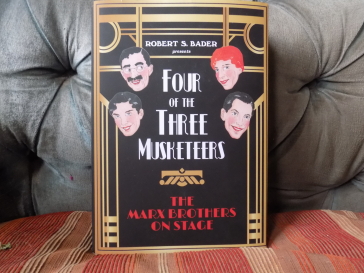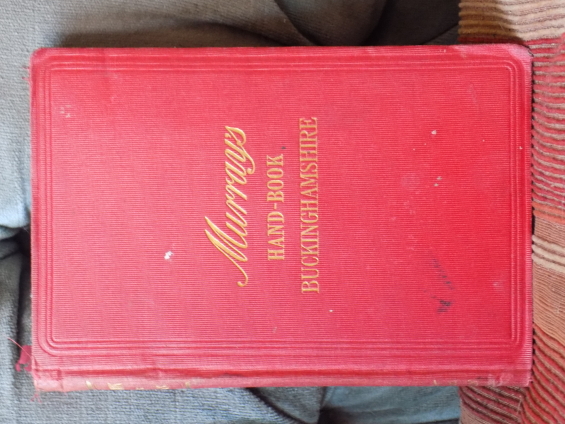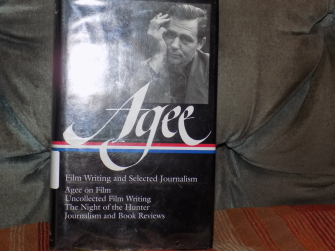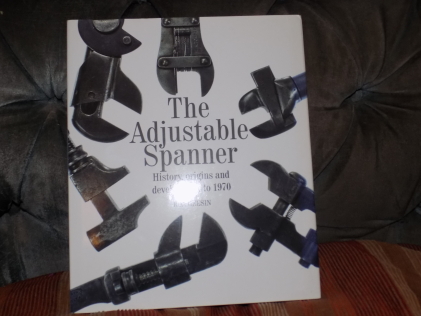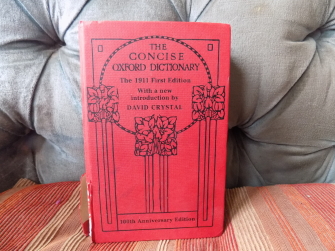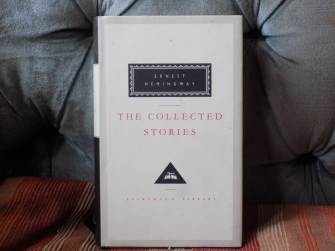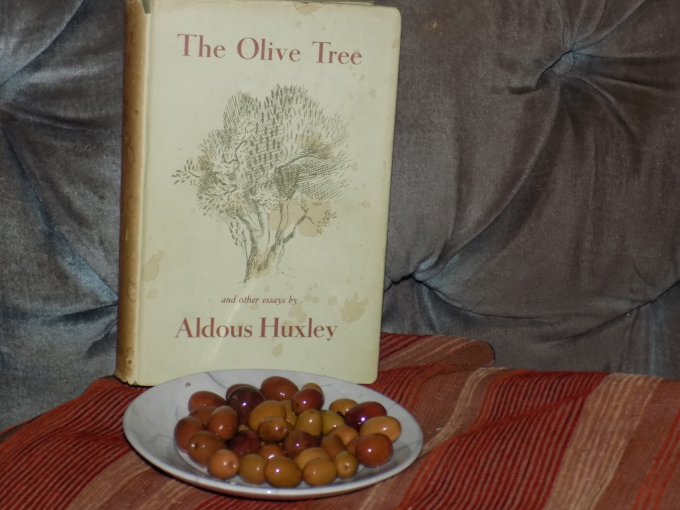Here is a link to my article about P. Y. Betts's novel French Polish (1933).
https://neglectedbooks.com/?p=9442
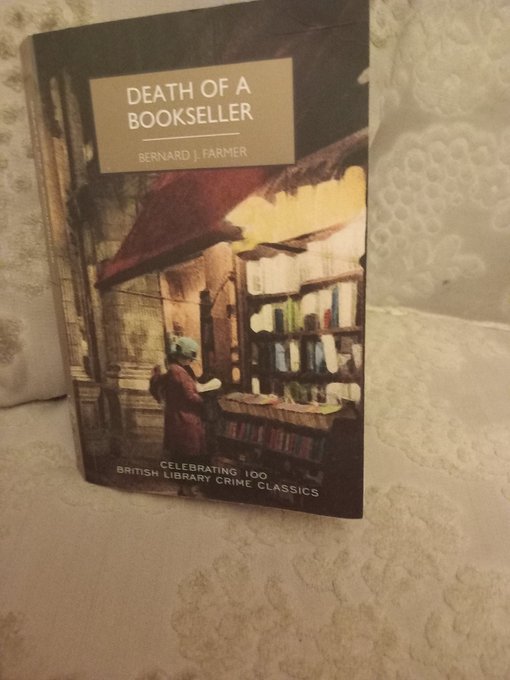
A BOOK ON THE SOFA XXXXI
The Books in Fred Hampton’s Apartment. The title of that 1973 book by Richard Stern comes to mind when reading the British Library’s recent reissue of a 1956 thriller/detective novel Death of a Bookseller by Bernard Farmer. In Stern’s case, his title referred to the Black Panther shot a few years earlier; as for this novel, Fred Hampton is the name of a book dealer who has received a death sentence for a murder he did not commit.
Long sought after by collectors (a wrapperless copy fetches £50), it has been reissued in the British Library’s series of lost crime fiction. What’s more, it is the hundreth volume in the series and been accorded a gold wrapper - along with an alluring painting of somebody browsing beneath an awning one dark and rainy night.
Farmer had a varied career, seeing service in the Great War and the Police force, and all the while was one of that happy, driven breed who savour all that might lie beneath the dust of volumes retrieved from a bottom shelf in out-of-the-way premises.
His novel turns around a Superintendent who develops a taste for such diversions (it is a mark of those mid-Fifties times that Henty first editions command considerable sums across the Atlantic). Much of the plot turns around those vanished figures known as “runners” who scoured such shelves in search of items which would then work their way up the chain, via West End premises, and often end up on the shelves of those American collectors who had made a fortune in industry by themselves working a passage from near-poverty.
Such a character finds a place here, aided by a female dealer who does not shy from using a knife - not to cut pages but the flesh of those who come between her and a desirable volume. What’s more, there are some moments which appear to draw in satanic practices courtesy of instructions given by antiquarian volumes hidden, very Umberto Eco, upon the dead man’s private shelves.
For all this outlandish content, Farmer’s novel proves to be plainly told, too much so to carry aloft a tale with all these elements to it. One might look ahead instead to a first novel published at the end of April this year by Alice Slater. Its title? As chance has it, Death of a Bookseller.
A BOOK ON THE SOFA XV
I have written about William Plomer's novel The Case is Altered on the Neglected Books site. Here is a link.
https://neglectedbooks.com/?p=9367
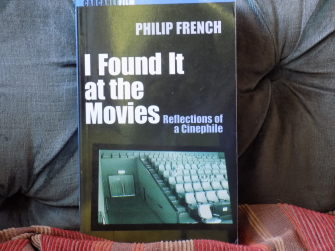
A BOOK ON THE SOFA XXXIX
Before the internet there was Philip French. By dint of schooldays' memorising of all the FA cup scores since the 1890s and then closely studying thirty cases to get a good Law degree at Oxford, he developed such a memory that if one mentioned, say, the cinematographer on The Third Man, he was able to cite there and then everything else that Krasker had worked on. Not that he was a machine, for his understanding of film, and much else, had a human quality which makes him on a level with his admired Edmund Wilson.
With much of his time spent as a BBC radio producer and as a weekly film reviewer for the Observer, he may have regretted not writing more than the half-dozen books that he did (along with editing the amazing Faber Book of Movie Verse). Towards the end of his life, however, he looked back and realised that he had “churned out millions of words”; the result was that he set about creating three volumes from these pieces, just as Wilson used magazines as a stepping stone to books of one kind or another.
One of these is I Found It at the Movies (2011). The title is, of course, an allusion to Pauline Kael's I Lost It at the Movies. Then, again, should one write that “of course”? How many people now read her flash-Harriet prose whose length was such a contrast with the incisive wit of Greene, Agee, Ferguson and, as we see here, French himself? As he himself puts it in a piece here, there has been far too much jargon-driven academic film analysis at the expense of considering those “critics who aspire to something more than playing the role of reviewer as tipster” - now symbolised in that grim custom of heading reviews with those illuminated stars redolent of the days when infant-school teachers affixed such items to pieces which had alleviated their toil through exercise books.
Who but Philip French would begin an article with reference to the neo-classical houses designed by Robert and James Adam before turning to the subject in hand, which was that inhabited by the family which came from the pen of Charles Addams? And that by way of the New England Adams clan who provided the country with two of its Presidents. An article about him by French so impressed Addams that he allowed him to visit his Manhattan apartment for a radio interview. “Visitors had to leave the lift at the twelfth floor and climb a dark staircase past a door ominously marked '13'. My eyes popped like a character in an Addams cartoon. The flat into which I emerged was like a little museum, with rows of ornately carved crossbows and suits of medieval armour... He served me tea in a mug decorated with a memorably gruesome detail from a cartoon (a man being swallowed by a snake) and we proceeded to record a long, relaxed, informative conversation. He rejected psychological explanations, but he did reveal that he had a great fear of snakes, something he had worked out through drawing them”.
Small wonder that one of Addams's weddings was in a cemetery.
And all this takes up but a paragraph of one of the book's three-hundred pages. Open it anywhere and there is equally entertaining edification. He wrote a last piece, about The Ladykillers, the day before he died; the second volume of this series – his film reviews - was edited by his widow and three sons; and the third is yet to appear: we need it now more than ever, for he was an emblem of civilisation.
Especially for those of us never awarded a star by the Marie Kondo Academy of Decluttering. A treat at the genial house run by Philip and Kersti French was to visit his cinema room. He had a projector long before others did so – and the seating comprised piles of videos for which there was no room on the shelves. If only Charles Addams had known of this!
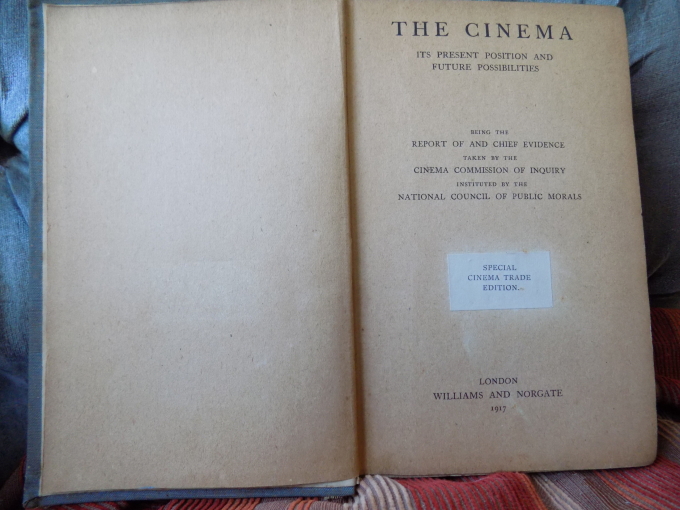
A BOOK ON THE SOFA XXXVIII
Covid has made life hairy for cinemas. A century ago, however, there were problems highlighted by the National Council of Public Morals.
So much so that some may have wondered whether cinema would survive clerical strictures.
Of course, we know that it did, and went through that Thirties and Forties era recalled by Graham Greene as a “Pleasure Dome – all those Empires and Odeons of a luxury and an extravagance which we shall never see again”.
These thoughts are prompted by browsing in a 400-page volume, published in 1917, which collects all the details of the Inquiry held by that National Council into the state of Cinema. This was inspired by its Inquiry into the falling birth-rate. The name of the Bishop of Birmingham looms large in it. He Chaired meetings at which all concerned gave their evidence, including children who elaborated upon their favoured viewing: they preferred Chaplin and chases to beautiful views of nature in all its glory.
Quite possibly, I was the only person on this planet (let alone others) to be looking at this volume in today's early hours. History entails a trawl through volumes which might lack sparkle but can contribute salient material to livelier accounts of that era. Cinemas were then smaller than those which would show the talkies which drew crowds to Odeons and Empires. This volume lays some emphasis upon cinemas without ventilation being a source of disease (children with nits, a need for disinfectant sprays during screenings); and yet the clergy hoped that it could encourage an enjoyment of music – all those instruments which accompanied the silents.
Perhaps the most interesting section is the concluding one in which various areas' Chief Constables comment upon the gathered material. After Sir William Gentle has averred that Brighton can be seedy, step forward D. Smart who asserts that Brechin is far worse: “speaking from my own experience of about thirty-five years' police service among the criminal, wastrel and other classes, I claim to have seen a few 'ups and downs' in the world during these years; and among the many other things that have been got up with a view to giving amusement and pleasure to the people, I consider the cinema is one of the poorest and meanest productions which have yet been produced to waste the time of those who attend them and to get their money”.
And Mr. Smart had only got going at that point; through the rest of page 340 he boils over, explodes, all the more so when reflecting that cinemas have taken over ecclesiastical premises.
Others make the point, though, that it keeps people out of pubs while another Chief Constable is perturbed that the dark means that adjacent seats provide a chance for “spooning”.
Which, paradoxically, could have solved the previous inquiry's concern about that fall in the birth-rate.
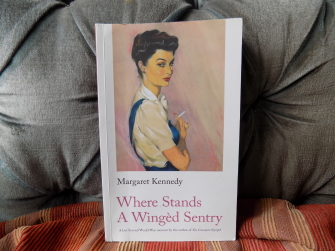
A BOOK ON THE SOFA XXXVII
Curiously, Margaret Kennedy's diary of the early part of the Second World War with her children in Cornwall was first published here last year – eight decades after it had done so in America. Still best known for The Constant Nymph (1924), she provides a crisp record which does not shirk anxiety (particularly about her husband's air-raid warden work in London) but has a relish of life amidst it.
“We have lived too easily, enjoyed ourselves too much. A world in which everyone was as happy as David and I have been would be a wonderful place. But if we want to secure such a world we must gird ourselves for a much sterner, more strenuous existence and never in our lifetime seek repose. After supper we went for what David calls a little waddle through the dusky woods, hoping to hear a nightingale. We didn't hear one, though the cook says they have been yelling fit to deafen her all the afternoon outside her scullery window.”
Fear of a German invasion is continual, the collapse of France doesn't help, but here is a vividly-peopled chronicle, with three pages about taking a score of evacuees to the beach being a superb story in itself. And a page about the Marx Brothers. “Generally I laugh extravagantly... and then feel depressed afterwards, as if my laughter had been exciting but not refreshing.” It will be interesting to find her study of film The Mechanized Muse – and indeed to read The Constant Nymph and a novel set on a Greek island, The Forgotten Smile.
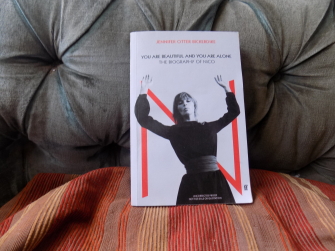
A BOOK ON THE SOFA XXXVI
A few weeks ago, I chanced upon a proof copy of Jennifer Otter Bickerdike's You Are Beautiful and You Are Alone, a biography, published last year, of the singer who adopted the name of Nico.
How does one read a book? Recently I have been reading, over a couple of weeks, last year's new biography of the Great War poet Ivor Gurney (and think to write about it). And, for some reason, last night I picked up the book about Nico - and read it at a clip in the early hours. They have something in common: death in their forties, after traumatic experience, their work little known by people at large.
As a biography, related in something of a conversational style, this is not exactly a match for the Gurney, but the very fact that it prompted a rapid reading means that there is more than something going for it.
The facts are largely known, and tied up in myth. Born in 1938 in Germany, she suffered the war, from which she emerged as, very tall and beautiful, a model with success throughout Europe. As such, with an ad hoc part in La Dolce Vita, she moved in film circles. An affair with Alain Delon brought a child whom he shunned. As a single mother, she found help, and by way of a 45-rpm disc recorded in London, she reached New York, where she became a part of Warhol's Factory – and, to Lou Reed's scarcely-controlled fury, a vocalist upon some of the Velvet Underground's first album whose few-hundred purchasers were to be influential.
Meanwhile, Delon had been but one of many esteemed lovers. Among them was Brian Jones while Jim Morrison encouraged her to write her own material; this was not to be a lucrative path, but it leaves us with a series of albums on which her voice is affectingly imperfect. If not as much so as, for example, those by the later Billie Holiday or the wonderfully whispering Mabel Mercer.
These were wild times (it would be a brave soul who reads aloud at a tea party the details of her technique in pleasuring Morrison); all the while, the undertow of pathos become stronger (new to me is that few visited his – then-unmarked - grave in the first years after his death). He died later the very night that he had not noticed her waving to his car from a pavement.
To keep going, she needed cash in hand, which brought relentless small-club touring, a progress dogged by a heroin addiction – despite which she was able to give a couple of hours every day to the The Times crossword (she was fluent in half-a-dozen languages). One of the many strange turns is that her cosmopolitain progress brought a long stay in Eighties Manchester which coincided with its emerging musicians proclaiming their debt to her, and fostering that touring.
All the while, of course, there was, in the words of Neil Young's song “The Needle and the Damage Done”: her pre-performance retreat to a bathroom to find a vein to ingest the stuff. The wonder is that she kept at it, and, even more, so that there were signs she would pull through it with a 1988 retreat to Ibiza. There, though, in renewed contact with her troubled son, she took a mid-morning bicycle ride down a hillside only to topple from it. This was quite possibly a stroke and, after she had been found, it took some while to find a hospital that would accept her – and the one that did so was unable to find a vein now wide enough to take the injection that could have saved her.
“All Tomorrow's Parties” were yesterday.
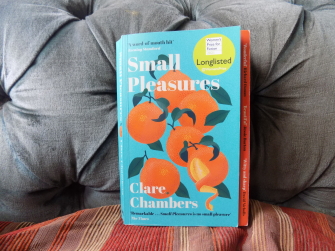
A BOOK ON THE SOFA XXXV
“I wonder when Forster will publish another novel?” How often that question must have been asked around the world when there was increasingly less sign of a successor to A Passage to India (1924). What's more, it could have been asked during the fourteen years which had passed since Howards End. After all, Forster's career had begun with four novels in five years. And his final novel might never have been finished without the encouragement, as he acknowledged, of Leonard Woolf.
All this is a preamble to celebrating Clare Chambers's Small Pleasures (2020). Miracles can happen (I typed that phrase, the subconscious perhaps prompted by the novel's plot). She had not published fiction for a decade, and if she were able to do so again, it was in full expectation of being, at best, in that doom-laden term, a “mid-list” author. She had written seven novels, which was more than Forster, and she shared his eye for small-scale human comedy. And I am reminded that I wrote of one of hers that “to warm the heart and chill it is a rare ability”.
Small Pleasures does so again. And how. It opens with a purported local-newspaper report of a real incident, a December 1957 railway crash at Nunhead – on the Charing Cross-to-Hayes line - which killed four-score and left two hundred injured. As with Melissa Harrison's equally moving At Hawthorn Time, one puts the opening accident out of mind, if once in a while wondering about its bearing upon the unspooling of events.
These take place over the previous six months, and bring with them time past in a meticulously-observed time then-present: puddings, cars, washing lines, radio programmes, gas fires, big knickers, and more, spring naturally from these pages unforced by any hothouse of microfiche or search engine.
Jean Swinney is a reporter on that male-dominated, smoke-filled local newspaper when it is apprised of a potentially sensational story: a woman who claims that her daughter is the result of a virgin birth. Naturally, there are doubts (it is not mentioned in the novel but there was a custom of VD clinics accepting vicars' assertion that they must have caught the disease from a public-lavatory seat). Even so, given that this could be front-page stuff, with serial rights beyond wildest dreaming, Jean is deputed to pursue the story through half a year and forty chapters.
Pursue is perhaps not the word. She is no journalistic firebrand, what with breaking off to write household hints and to cope with her querulous mother for whom routine is well-nigh parade-ground stuff upon a faded rug. In that household, after dark is not a film-noir term but a matter of tuning in to the Light Programme. Open the novel anywhere and there are sentences with that Forsterian ring of discreet truth. “This was not the whole story, but a portion of it that could be offered up to outsiders without embarrassment.” “A gang of children was wading bare-legged in the water with jam jars and nets; they turned as one and stared after the car with tribal hostility as it passed over the bridge.” “The side gate was locked, so Jean pressed the door bell for just longer than was polite and waited, rehearsing various phrases of friendly concern, which turned to frustration as it became apparent that they would not be needed.”
Small Pleasures is a literary, life-enhancing equivalent of the Beatles: wildly popular and wonderfully good.
Clare Chambers studied at Hertford College, Oxford – and we can only regret that, unlike her, a fellow graduate (a century earlier) John Meade Falkner wrote only three novels (praised by Forster). Would that he had met with such encouragement. One can feel sure that, a century from now, readers will be urging Clare Chambers upon one another. As much as they do Falkner and Forster.
I began to read this novel upon a sofa, from which I had to prise myself to catch a train, and it made that harder, painfully narrower seat as comfortable as the one I had left. What's more, the ticket inspector walked on. Perhaps he had made a note to read Small Pleasures.
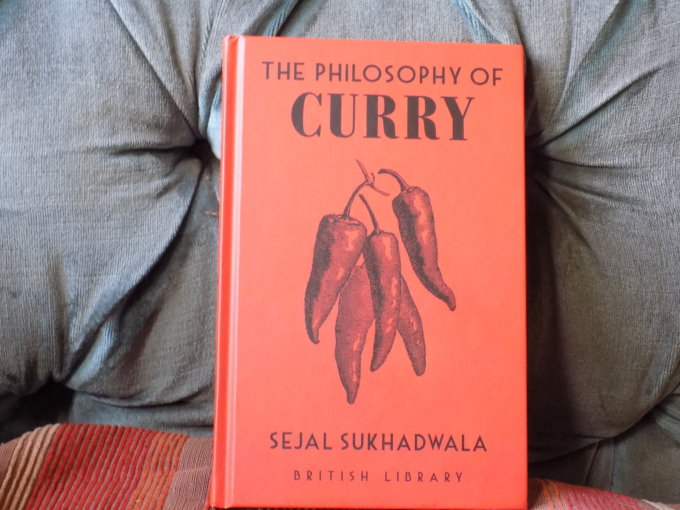
A BOOK ON THE SOFA XXXIV
“Shall we have a curry?” A seemingly simple question but, as Sejal Sukhadwala shows in her recent The Philosophy of Curry, one with many ramifications.
This is not simply a matter of those long menus which offer every permutation under the sun (or, when pubs close, the moon). The etymology of the word is as variously documented as the geographical origins of the food itself. What can be said for sure is that its esteem spread with the arrival of the English in India and their return from it, so much so – and new to me here – is that George V ate a curry every lunchtime for thirty-five years, just as his grandmother Queen Victoria had been partial to them.
One of the earliest documented ways of creating a curry was made in the second century, but the various Indian forms of cooking - from boiling to dry-roasting - came from many centuries earlier; indeed, around 1500 BC, there had evolved slow cooking by means of creating a fire from cow dung so that meat would become tender rather than be hung only to go off in the heat.
If a restaurant were now to proclaim that it uses retro cow-dung heritage cookers, this would cater to a niche market whose first customers would be followed swiftly through the door by a Health and Safety platoon with closure orders fixed to its bayonets. Too bad, though, that many a restaurant is now far less enterprising. Here in Hove a few years ago, I was visited by a friend who did indeed suggest that we have a take-away. A distressing legacy of his schooldays is that he cannot eat onions, and so he asked at the counter if his order could exclude them. The dismal answer was that this “is how the sauce arrives from the factory”.
With which, we left. Happily, a little further away there is the Hove Tandoori, opposite our town's fabled Carnegie Library. This is an unfailing delight. It is open at lunchtimes, whose couple of hours are mostly to prepare freshly the ingredients for its busy evenings. Here are dishes not sloshed about with “sauce” but served, at modest cost, in a dry method that highlights every ingredient. And, encouragingly, Sejal Sukhadwala shows that there has been a fall in the sales of off-the-peg “curry powders”.
Her short book traverses much ground, including a section on the growth of curry houses here after the Second World War. Well-illustrated, an elegantly-produced hardback, it is part of a British Library series whose philosophical subjects include Tea and Coffee, not to mention Gin and Cheese, as well as a new edition of a nineteenth-century discourse upon Beards (some of which could certainly have been a hazard for curries). It can perhaps be read over poppadums while others at the table are dithering over the rest of the menu – and, like the best restaurant menus, it is something to which one will return for the rest of one's life. A delight.
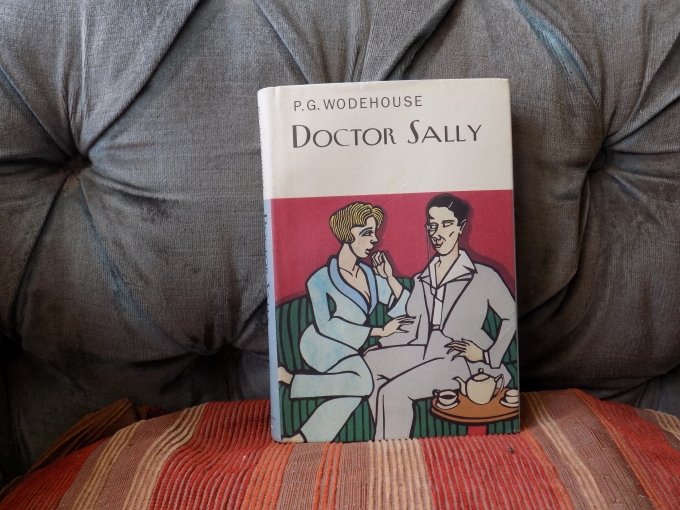
A BOOK ON THE SOFA XXIII
Brush up your Wodehouse. There is rarely a moment in times good and bad when one cannot reach out for one of his books, all of which have now appeared in the well-produced Everyman series. With Doctor Sally (1932), which is a third the length of another lesser-known novel Bill the Conqueror one might be moved to construct a theory around his penchant for the name Bill – not least in the eponymous song, for which he supplied the lyrics in a prolific stage career.
Doctor Sally started life five years earlier as a play Good Morning, Bill itself adapted from a Hungarian, presumable Bill-less farce. If there is less of Wodehouse's descriptive bravura here, with an emphasis on the dialogue, there is sufficient to carry
one though another tale of golf, misunderstandings and a country pile which tests Sally's bedside manner.
Who can fail to relish this? “The thin mist which had been hanging over the resort since lunchtime disappeared and there filtered through the windows of suite number seven on the second floor that curious faint gamboge light which passes for sunshine in England. Its mild rays shone deprecatingly on one of those many-coloured carpets peculiar to suites at south coast hotels”.
Wodehouse was a master of long sentences which seem anything but (these are in fact longer than this quoted section). And now I must hasten not only to use “gamboge” but also to adapt this exchange about dairy-farm techniques.
“'And what's that little ninctobinkus?'
' That - ' Bill paused, the better to prepare her for the big news. 'What,' he said passionately, 'is the Holstein butter churner.'
'O – o – oh!' breathed Sally.
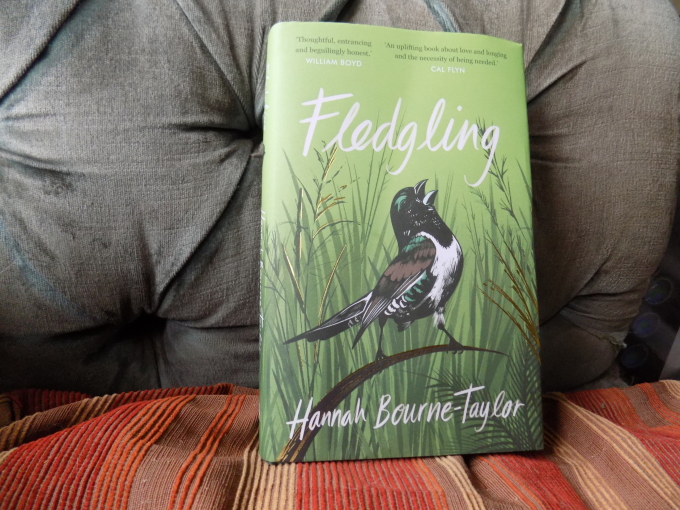
A BOOK ON THE SOFA XXXII
These high-tech, relentlessly interconnected times have brought in their slipstream a relish of books about nature's innate ability to communicate which lifts it way beyond the wildest dreams of a lithium battery. Scarcely any need to mention here that, with the beginning of the covid pandemic, so many woke anew to the sound of birds whose delicate throats were no longer outdone by the rattle and thrum of traffic.
Their music regained the air. And now, two years on, this has been joined by a chorus of praise for Hannah Bourne-Taylor's Fledgling. For those who may not have heard, this describes the homesickness of accompanying her husband, Robin, to Ghana, where he is engaged upon matters educational. Such is that country, she herself was not permitted to work, a stay-at-home situation which leads her to question the very nature of existence.
One can feel her housewife agony, that sense of days slipping by. Equally, that moment when her book lifts off, taking wing with the discovery of an injured bird whom she tends, learning as she goes, in a quest to enable the creature to rejoin those flying outside in a sky where kites threaten to descend from on high.
Here is a book so wonderfully told, facts imbued with a poetic spirit, no word wasted, that one does not speak lightly when saying that its narrative brings to mind the prose of To Kill a Mockingbird.
Evocation of that African landscape entails such facts as Accra's dust-carts broadcasting music, in the style of ice-cream wagons, as they make their rounds. Similarly, it must be news to many that scorpions are the planet's longest-surviving creatures: their ancestors would have scuttled beneath the feet of dinosaurs. And perhaps they will outlast the species to which we precariously belong. News to me that canaries were used here until the Eighties to detect poison gas in coal mines (not something mentioned during those strikes).
And there is a pleasing paradox that an internet link enabled her to discover the timbre of bird sounds and replicate them herself in a bid to bond with, and encourage, a stricken bird who treated her hair as a nest and the rest of her body as a lavatory.
The great success of Fledgling is that, in such ways (and there are many more of them), Hannah Bourne-Taylor makes all these creatures vivid but, in resisting the temptation to sentimentalise them, treats them as palpable individuals (among these are a spider and a dog). How to sum up such a book? Perhaps best to quote from it. “Through understanding the finch, I found it easier to relate to each creature and to respect and admire and to understand the natural world as a whole. I found myself capturing moments - from the gliding kites to the way the light danced on the river's surface or how the bamboo creaked like an old boat. I was building my own collection of wonders because the more I noticed, the easier it became, as though a blindfold had been lifted. And the brilliant thing about it was that I knew I could access it anywhere. I could keep building my collection long after the finch, long after the days lived in Ghana because it was an attitude – a way to look at the world.”
All those who read this book will find their view of the world changed for the better. It does not contain any photographs; the prose does its own work; although one might feel churlish for pointing out the tautology of “dead corpses” and “abseiling downwards”, this is in fact a tribute to its compelling one to savour every word, no temptation to skim.
Meanwhile, here in Hove, the sky is of course dominated by the ever-quizzical seagulls, but in fact we can be pleased that all new buildings have to include suitably-positioned nesting-bricks from which swifts can descend.
What will Hannah Bourne-Taylor write next? We are eager to find out while shying from putting her under any pressure – as she did while caring for a creature who had to take the necessary time to flourish. Oh, and here is an opportunity to mention John Bowen's mid-Eighties novella, Squeak - about bringing up a pigeon - which heralded his return to writing novels, which included that masterly depiction of Oxfordshire life The Girls.
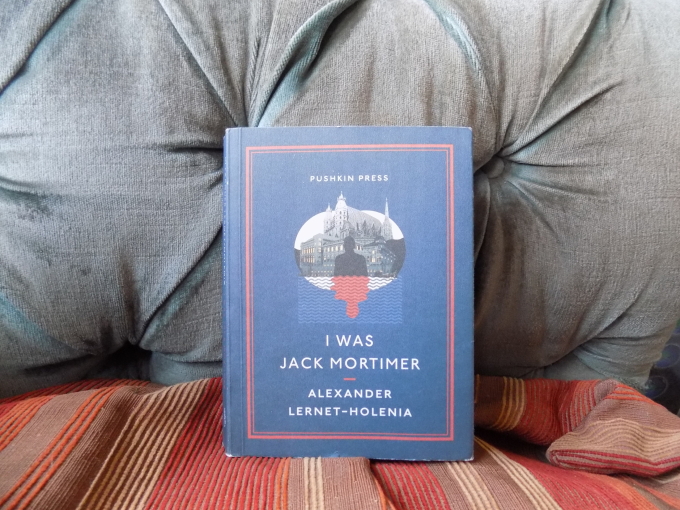
A BOOK ON THE SOFA XXXI
“He flipped open the passport. One passport photo is usually much like another, never mind the bearer.”
If one sentence can encapsulate I Was Jack Mortimer, this is it. Alexander Lernet-Holenia's two hundred-page novel appeared in Germany nine decades ago and has been filmed a couple of times but, in effect, sprang newly formed to readers here when the ever-enterprising Pushkin Press published Ignat Avsey's translation in 2013.
To us, it might, at first, seem the work of an Austrian Buchan. The driver of a cab, Ferdinand Sponer, finds that a passenger has been shot dead. Who could have done such a thing and fled the scene unobserved? This is the classic case of a man who, perforce, has to go on the run. Not that he gets as far as Richard Hannay.
When Graham Greene and Carol Reed met the Hollywood producer David Selznick, they were startled by his suggestion that the title The Third Man be changed to, er, Night in Vienna. Reason prevailed. There have perhaps been some who would think the latter apt for this brisk novel. After all, it takes place through one night, albeit in a Vienna as far from Strauss waltzes as Greene's screenplay would be.
Come to think of it, The Third Man could also have been the title of this novel. It does not give away too much to say that, in a panic, Sponer disposes of the body and, in taking the dead man's papers, continues the journey to the hotel which had been his destination.
This is to reckon without the third man, the murderer.
All this is told from the point of view of Sponer. Which makes it surprising, some way in, to find a jump back to the American South, where a song is turned into a Tin Pan Alley hit. Suffice to say, this – along with details about the Mexican way of saddling a horse – is done briskly enough not to distract from the night in hand and its depiction of boarding houses run by intransigent landladies. What's more, this fast-paced meditation upon identity would resonate with Lernet-Holenia himself. He was caught between writing for himself and appeasing those who came to power in that very year of 1933.
Enough! Read it for yourselves. And also savour its fitting comfortably in one's hands, whose fingertips take pleasure in turning good paper. Small wonder that the verso of the title page states, “proudly printed and bound by TJ International, Padstow, Cornwall on Munkem Premium White 90 gsm”.
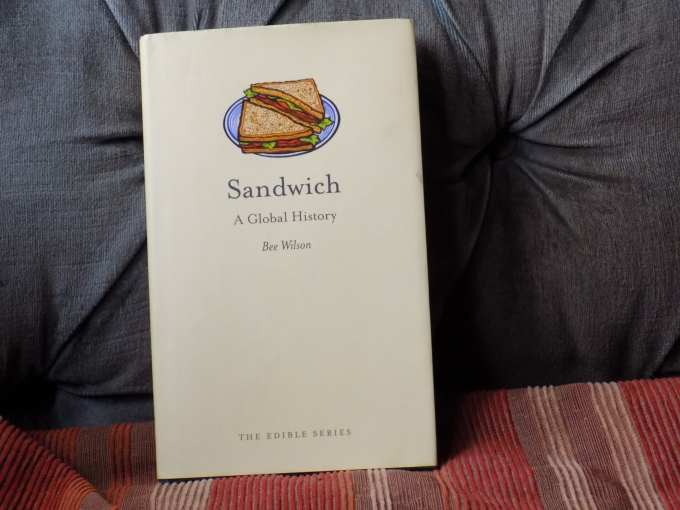
A BOOK ON THE SOFA XXX
Sandwich. Somebody somewhere, many of them, is saying that word as I write this one.
In the Eternal scheme of things, most of us cannot hope to live much longer in the general memory than a lunchtime snack. How we envy John Montagu, dead these past 230 years but on millions of lips every day.
Nobody, of course, asks for “a cheese Montagu on rye with extra tomato and a dash of bream”; a staple of every pub quiz, though, is that, as Earl of Sandwich, he gave his title to something which can range from a factory-made, railway-station horror to a near-on feast.
Those pub-quizzers might assert that the Earl created the meal by dint of being reluctant to grease his fingers during a fast-paced card game. As Bee Wilson shows in this elegantly-produced volume, published in 2010, it is more likely that as an Admiralty civil servant, he had recourse to this ad hoc, breaded device while working through what should have been a lunch hour (which makes him very much a twenty first-century figure).
What – so far as I know – still goes unmentioned is that the term “sandwich” was aided by its two syllables. The first one - “sand” - is long, suggestive of something being stretched out; while the short one of “wich” is redolent of those ingredients being squashed into place.
Bee Wilson shows that the sandwich did not emerge from the Earl's light-bulb moment (or its candle-lit equivalent). Worldwide, there were anticipations of it, just as there are now “brands” which play high-priced havoc with it across our planet. The canny, of course, make their own (decorously, Bee Wilson does nor refer to the 1998, Judge-puzzling case of “Linford's lunch-box”).
What makes a good sandwich? We are all familiar with what are merely bread sandwiches but Bee Wilson highlights what were termed in 1890 “mouth-distorters” (one of her children contends with one of these in a photograph).
As such, even now I reel from a visit to Newcastle, where I saw in a take-away window the phrase “half-stottie with everything”. So far as I could tell, this was a chip buttie gone wild.
By contrast with that, I have just referred to the Oxford edition of Wilde's The Importance of Being Earnest, and find that, although cucumbers are indexed, there is no annotation about their social standing in the 1890s. Which made me recall that, a century later, Susan Boyd told me that she was mortified to watch a documentary about Marie Claire magazine and see herself breaking off a corner from a sandwich before eating it.
What would Wilde, and even Lady Bracknell, have made of that?
And would they have relished Paul McCartney's favourite sandwich? As he elaborated last year: “I do a very good sandwich. I take a bagel, I cut it in three. Often you have two bagels, so now you cut it into six. So you’ve got a top and a bottom, a top and a bottom, and two middles. You can get three sandwiches out of that. So the bottom layer I put Marmite on and then I would put a little bit of lettuce, because I’m going to put hummus on but it’s going to go through the hole if I don’t put lettuce on. You might get a little sliced cheese on there, you might have one slice of tomato, then you might have a little pickle or two. Then you go back to your lettuce barrier, because there’s another hole on the top remember, so you’ve got to protect it from that. Then I put on honey mustard.” What's more, he is keen on reusing paper bags to carry the sandwich about with him.
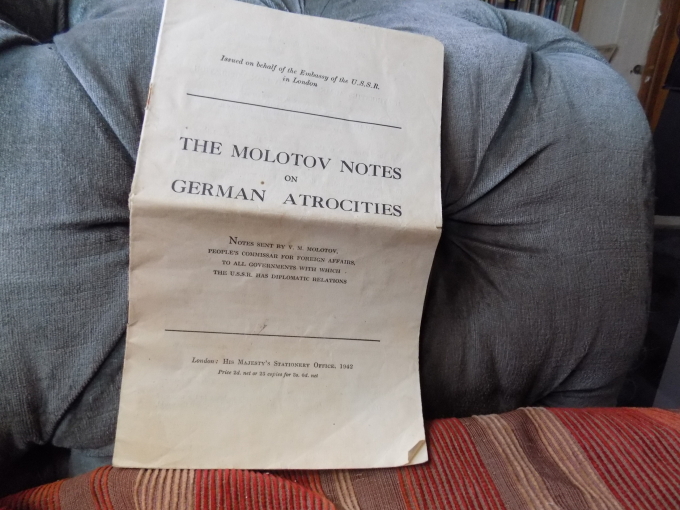
A BOOK ON THE SOFA XXIX
“Molotov arrived secretly in Scotland last night where he was met by the royal train, and brought to London, where he has been hidden. Nobody knows of this, hardly anyone. I had much pleasure in telling Rab this evening, who was astonished.”
So noted Chips Channon in his diary on Thursday, May 21st 1942. Strange, these perilous arrivals in Scotland at that time. A year earlier, Hess had done likewise – and was to die in 1987, a year after this Soviet counterpart.
Molotov, however, had been successful in his wartime mission, for it completed the Anglo-Soviet Treaty. All this thought, here in 2022, has been prompted by the current war in Ukraine. That pamphlet was issued by His Majesty's Stationery Office – on behalf of the Soviet Embassy - two months before Molotov's arrival under darkness.
Its twenty pages document the horrors perpetrated by the Nazis upon such countries as Ukraine. “These evil crimes of the invaders are going on everywhere, and are being accomplished on orders from above.”
Eighty years on, there is hardy any need to highlight the irony of this: “If the invaders meet these people on the roads they take the clothing off their backs, even from the little children. They cruelly treat all who try to to protest or show any resistance to their ravages.”
Molotov supplies many details.
All of it can be summed up by the indelible image of a woman bayoneted through the baby she was holding to her chest. That baby, even her mother, could have been alive now.
Not only is Russia now perpetrating horrors similar to those which Molotov decried, but he himself was, in effect, to blame for them. In 1939 he had signed a Non-Aggression Pact with Ribbentrop, the upshot of which was that Germany invaded Poland – and the rest we know, with that address to the nation from Downing Street in September 1939.
Two years on, Hitler ripped up the “deal”, and the axis turned. What's more, it emerged after the war that while writing this pamphlet Molotov had been more than complicit in killing off Russians who dissented from his master, Stalin's line.
Meanwhile, in the pamphlet, people here were told, “in the village of Voronki, Ukraine, the Germans put 40 Red Army prisoners of war and medical nurses in the building of a former hospital, and took away from the medical staff all bandages and medicines, food and other belongings. They raped and shot the nurses, left a guard over the wounded men and refused to allow anyone to approach them for four days. Some of the wounded men died, the rest were later thrown into the river, and the local inhabitants were forbidden to take away the bodies.”
1942 is not so long ago. Many now alive remember it well. Yet again, our planet lives through a mirror image of history when. instead, we could be celebrating and encouraging all that our brief stay on the planet has to offer. Had the Versailles Treaty been managed along Keynes's lines, there would not have been a repeat of the centuries' confusion which fomented that “Great War.”
Why covet territory when life can be enjoyed in a room of one's own?
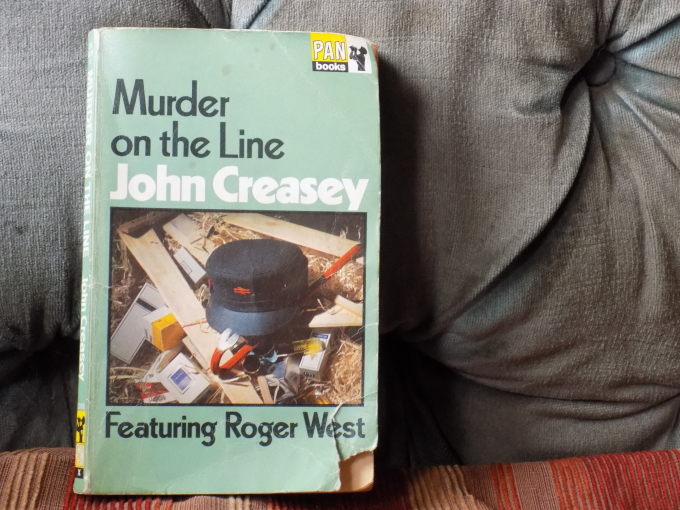
A BOOK ON THE SOFA XXVIII
Where do books end up? They emerge, at speed, fresh from the printing machine, soon to be sent hither and thither, so untraceable as to be the envy of any criminal, their path duly slowing as their spines weaken and they can go no further.
Survivors can find themselves the object of a large reward. This is probably not the case for Murder on the Line which I rescued from a skip in Hove the other day (a few hours later, and it would have been swollen to pulp by the rain). Creased, one might almost say. John Creasey wrote numerous novels, under various names, seven-thousand words a day no nire of a hurdle for him than it was for the more poetically inclined Dickens.
Creasey was everywhere. How widely is he now known for these books which keep well under two-hundred pages at a time when thrillers have become so nordically baggy?
I had never read him until chancing upon this one. First published in 1960, this novel became a Pan paperback eight years later. An immediate allure is that it opens in a railway's signal box, which always heightens drama. And, in this case, brings the equally prolific Simenon to mind. Not far into this tale set in and around the New Forest, one comes to suspect that it would be far better known now if the Frenchman's name were on the title page.
A faithful husband is coshed while at his work in front of the levers in the box one night, just as a car's lights shine upon the villain while it is halted by the crossing-gates. Not only does Creasey put the reader immediately in the midst of things, he establishes the relationship between one and all with adroit pace. Whether he is describing the Scotland Yard team – led by Roger West – or the denizens of a boarding house who are but one tier in a nationwide racket, Creasey provides just enough detail for these to become substantial rather than stock figures, many of them kept awake by their thoughts as a street light comes through the curtains.
The geekish among us might look closely at the paperback's cover and note that the cap sports the symbol of British Rail; the pages within, however, are resolutely faithful to its predecessor British Railways, a terrific reminder of that period before the Sixties got up steam.
No phrase leaps from the page in demand of quotation (although the command “slippy”, for be quick about it, was new on me); each word, though, has a place in moving everything along.
John Creasey deserves better than a skip.
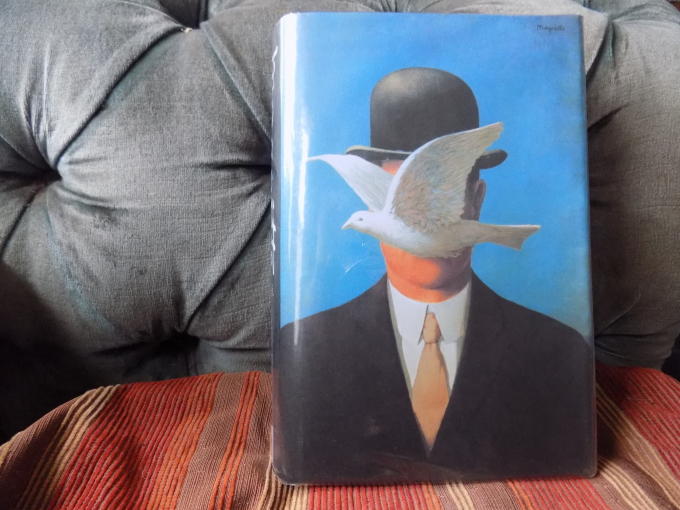
A BOOK ON THE SOFA XXVII
So familiar are many of Magritte's paintings that they no longer surprise. One fully expects a railway train to emerge from a fireplace or an undertaker to offer a coffin to suit those found dead in an armchair. A glance out the window could find a dark lit by a streetlamp street beneath a blue sky.
There is now an inevitability about them. And yet how many people know much about the artist, who died in June 1967, and in that Summer of Love did not know that his work would inspire the label for discs issued on the Beatles' Apple label?
Magritte lived at a tangent to most of the Surrealists, although he was buttressed by such people as Nougé who even supplied titles for those conjured by observation and imagination. Alex Danchev died six years ago, with one chapter left to write of this recently-published biography (which has been added seamlessly by Sarah Whitfield).
His was not a life crowded with incident; the revelation of Danchev's biography is the amount of thought which lay behind the work. Magritte's collected writing amounts to seven-hundred pages in French, and a full edition of his letters is yet to appear (there is nothing by the acute and troubled Nougé in English).
Danchev conveys all this well, and, in counterpoint to that, offers a dual surprise: Magritte had the ability to forge others' work in times of financial crisis (these were frequent, he never netted the millions that his work now commands); what's more, he was part of a scam, the source of the large-denomination banknotes which others spent in small establishments, an almost-Ealingesque situation, for which, unlike the Lavender Hill mob, they were lucky to escape prosecution.
Illuminating as the biography is, it is darkened by the rough paper upon which it is printed; unpleasant to hold, this also blurs many of the illustrations (reduced to black and white) which supplement interestingly the better-known work presented in two full-colour sections.
At £30, we deserve better.
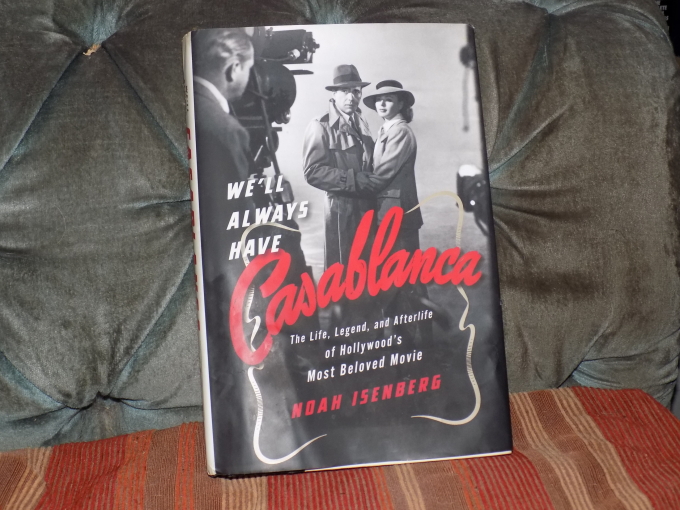
A BOOK ON THE SOFA XVIII
Sooner or later, exponents of the auteur theory have to address themselves to Casablanca. Whose work was it?
The subject has filled several books. Among the latest is Noah Isenberg's We'll Always Have Casablanca, a punning phrase which has the lumbering sub-title The Life, Legend and Afterlife of Hollywood's Most Beloved Movie. Published in 2017, this claims to bring “the story into the twenty-first century”. It is in fact a re-make, very much in the shadow of Aljean Harmetz's Round Up the Usual Suspects: The Making of Casablanca – Bogart, Bergman, and World War II which appeared three decades ago.
Here, again, are the familiar demarcation disputes. Which screenwriters at Warner Brothers did what in adapting an unproduced play whose authors provided much of the framework for a movie whose daily progress was a mystery to those who filled Rick's Bar and its other locations.
“Schmucks with Remingtons” were bashing out revisions just in time for those on the set to learn those lines while director Michael Curtiz sought vocal relief in a locked room. Some of the crew wired this for sound: his cries of delight were broadcast to one and all while, over in Washington, the censor insisted it be made plain that Rick and Ilsa did not enjoy similar pleasure.
So could the censor be the movie's auteur? It shimmers with suggestion, both in Africa and Paris. A point emphasised by Isenberg is that some two-thirds of its cast – an exemplar of ensemble working – were immigrants. There was a ferment to its progress, something which, one might infer, is felt by viewers eight decades on. The energy remains palpable. Words are suited to deed, whether lofty, shameful or, most pertinently, in that grey margin between them.
Isenberg stumbles when it comes to the “legend” and “afterlife”. One hears throughout the low rumble of a search engine as these “hits” are given paragraphs whose linking is as rough as the paper upon which this book (unusually for America) is printed. One almost senses that the publisher reckoned this book will not stick around.
As for that “afterlife”, there should surely have been some mention of another terrific Bogart movie, written on the daily hoof (by Truman Capote) from a little-known novel by Claud Cockburn: Beat the Devil. Perhaps the best account of this appears, at welcome length, in the memoirs of Sheridan Morley, who was there with his father Robert, whose part in the film was as unexpected, and effective, as any of those who found themselves – in sickness or in health – propped against Rick's bar.
Naturally, one can welcome yet another viewing of Casablanca but do not let this be at the expense of the journey to northern Africa that is Beat the Devil.
Perhaps, to take another French turn, each viewer is the author of what appears upon a which screen which makes Casablanca more real than the place itself.
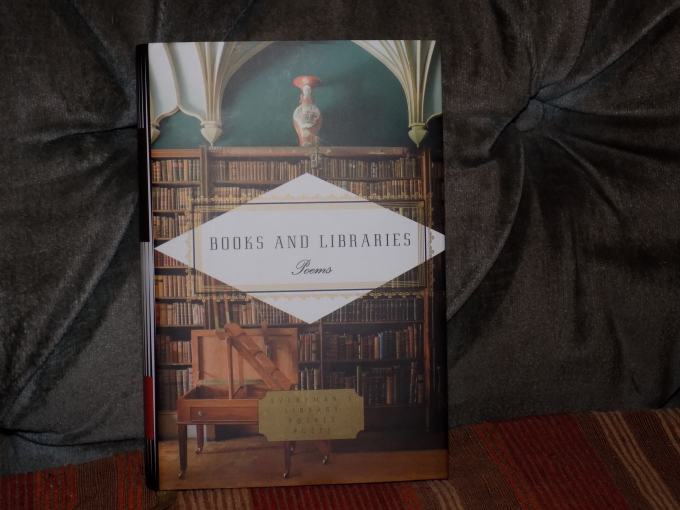
A BOOK ON THE SOFA XXVI
“The doughnut scent of it all, knowledge,
The aroma of coffee being made
In all those books, something for everyone,
The deli offerings of civilization itself.”
At a time when there is a perverse insistence upon libraries being made into ad hoc caffs rather than a repository for books themselves as caffeine for the spirit, how wonderful it is to chance upon these lines in a poem by Alberto Rios. These lines make the point that library readers relish libraries which steam with books, good books – and books, in all their forms, appear in a recent, pleasingly dinky anthology of poems, Books and Libraries, in the wonderful Everyman hardback series which fit into a pocket. The series includes, for example, Poems about Trees, as well as selections from Sondheim and Leonard Cohen. Not to mention those devoted to Dogs and Cats.
Whenever I see one I do not have, I buy it. Which means that one has Marvell, Milton, Wordsworth time and again. This might not appear the most economical use of precious shelf space (which can easily become floor space) but any poem in an anthology can bring others into a new light, across the decades, generations, centuries.
Pick up these 250 pages, flick to and fro, and one realizes that those long gone are with us now.
New to me is Lesbia Harford, who died at thirty-eight in 1927.
She wrote “Closing Time: Public Library”. And here is all of it:
“At ten o'clock its great gong sounds the dread
Prelude to splendour. I push back my chair,
And all the people leave their books. We flock,
Still acquiescent, down the marble stair
Into the dark where we can't read. And thought
Swoops down insatiate through the starry air.”
That is, surely, wonderful. Don't put an author's name to it, and you might take this for Yeats in his Tower.
I do not know her, but must seek out more. This is not an anthology I shall attempt to fit, small as it is, on the shelves; it will stay on this desk, a continuing inspiration for those of who know that books are the very thing we need in these tumultuous times – and beyond.
Not to mention public libraries open, and staffed, until 10pm.
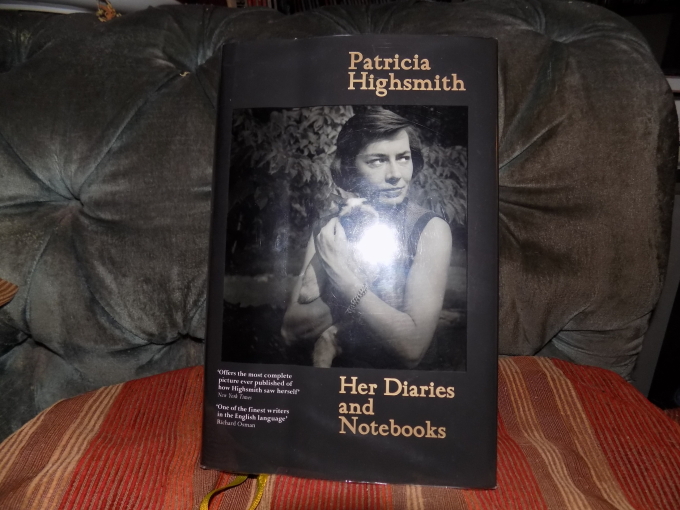
A BOOK ON THE SOFA XXV
How quickly should one read a book? The question comes to mind again while Patricia Highsmith's Diaries and Notebooks press upon the lap while making room, fittingly enough, for a cat who stirs now and then with the rustle of the pages. Perhaps this visiting cat realises that here is a 1000-page book (distilled from 8000 manuscript pages), and so he is guaranteed long, purring snoozes as one looks up, day after day, to savour these continually absorbing takes on life and love as 1941 becomes 1942, with death some fifty years away.
At twenty-one, Patricia Highsmith gets through books at clip in a Manhattan where she tries to forge a living as it becomes clear that writing is her destiny (crime soon takes a hold upon her imagination). Smitten and more with various women, and sometimes men, she ekes out life by such means as working on a magazine for mothers with new babies – and, at one point, sells some of her dresses (but promptly spends part of the proceeds on a book about birds).
While trying to be good bookwise here, I borrowed a copy from the library system in Hove and Brighton. It has only one copy, to be shared by fourteen branches. Chances are, then, that others will want it before I am in sight of the end.
Patricia Highsmith understood this – she was a great one for libraries, she frequently mentions them as a retreat. Books are as much a presence as music, and throughout the first 201 pages (and doubtless the rest of them) there are such observations as “a clever brain in sobriety will serve you even better when you are drunk” and “My feet are killin' me these days. I fancy it hampers my thinking as an otherwise perfect physical specimen”.
How much do those things stand up to analysis? That is not the point. Here is an amazing angle upon life in which purpose and distraction are in productively imaginative tandem.
I suspect that I shall have to get my own copy. After all, this has already prompted me to buy the memoirs of her friend, photographer Ruth Bernhard.
How disappointing, then, that so human a book has an undetailed, perhaps machine-created index: no entry for “cats”, let alone “Highsmith, Patricia”. Well, before taking it back to the Library, I might have to flick through the twenty references to Bach rather letting him pop up in her life as he does every day in mine.
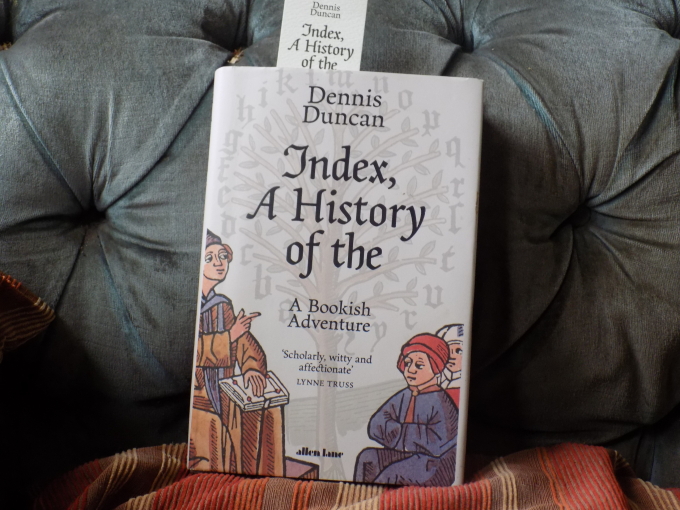
A BOOK ON THE SOFA XXIV
Naturally, if sometimes vexingly, authors are often asked what they are at work on. For some time, Dennis Duncan replied that he was writing a history of the index. Not the papal one but those found, if one is lucky, at the end of books. Lo and behold, Duncan was often told about the book by William Buckley which chronicled his bid to be Mayor of New York: as did so many, he'd had a dispute with Norman Mailer, to whom he sent a copy of the published book. Beside its two index references to Mailer, Norman he inked in red biro “Hi!”.
Dennis Duncan trumps all those informants. He includes in this book a photograph of that very entry (the copy is now preserved in a Texan library – Mailer did not sling it out in disgust). This is but a small, if telling part of a book which ranges across thousands of years, such giant steps pausing for leisurely strolls about that ever-verdant territory, the academic dispute (step forward, Alexander Pope and many who are now less upon lips or under fingertips). Who now reads Higdon's Polychronion? Well, a copy of the fourteenth-century Cheshire monk's world history took Duncan to the seclusion, one rain-lashed December afternoon, of the library at St. John's, Cambridge to study an, of course, manuscript copy of it – with an index out of synch with the preceding pages, and very fascinating he makes what might seem arcane.
Leap forward centuries, and things are sometimes worse. We are all familiar with those indexes that are simply a string of numbers. Compare, for example, the dismal index to the 1976 edition of Waugh's diaries with the comprehensive one to the continuing Oxford volumes of it. Meanwhile, there looms the computer-generated index. That this is a source of artificial stupidity is shown by Duncan's wheeze of having part of A indexed by a machine at the end of his own book, although he does not include a voucher for a gin and tonic so necessary after wincing through these three pages. Happily that gin turns out not be needed, for it is followed by the work of Paula Clarke Bain, who shows diligence and wit (in an echo of Mailer, she puts [Hi! Colleagues - PCB] at the top of the listing for the Society of Indexers, whose founding brought an elegant address by Harold Macmillan); what's more, under her own listing, there is: “non-robotic, superior index 309-40”.
Here is something for everybody who relishes civilised entertainment, a view from one's armchair of a sometimes barbaric world. A glimpse of Virginia Woolf finds her on her knees one Sunday afternoon, the rug covered by cards as she attempts to index, somewhat basically, a Hogarth author's memoirs. One misses, though a reference to somebody who later moved to her Lewes area: the presiding spirit of the London Library for many years was Douglas Matthews, whose railways journeys between Sussex and St. James's were occupied in compiling many an index for which he received high praise in authors' acknowledgments (another fertile book part, as Duncan's own demonstrates, although likening his work to the Tour de France is fanciful - even if cycling, too, is a sedentary task). Meanwhile, open any page – by dint of the index or otherwise – and edification springs forth. Not only did Henry Wheatley's pioneering What Is an Index? (1878) at first lack an index but it sported as an insignia an engraving, by John Fenton, of a walking scholar, book under his arm while looking at a fingerpost in the remote countryside – all of this framed by a snake chasing its tail, a form known as the ouroborus. This allows Duncan to provide a brief disquisition upon its origins upon the tombs of Ancient Egypt and to suggest that it represent a chaotic world beyond the order that is an index or fingerpost.
In such a spirit, page 282 is tantalising: this note, unindexed, reveals that A Literary History of the Chapter - by Dames, Nicholas - is forthcoming from Princeton.
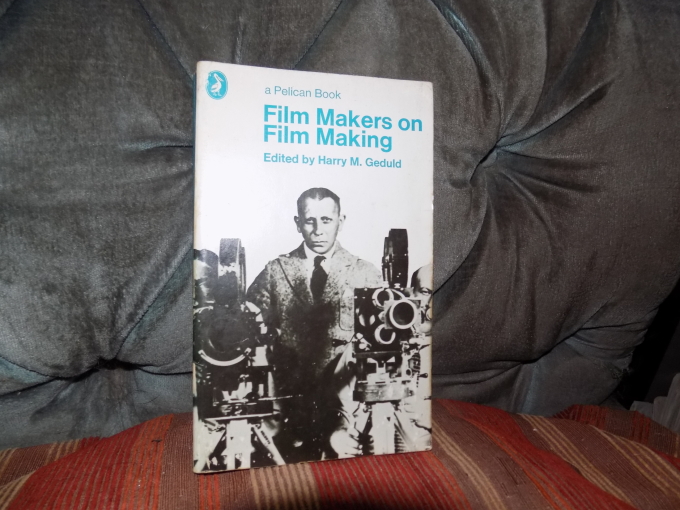
A BOOK ON THE SOFA XXIII
How long does a book stay in circulation? The question came to mind a few days ago, when I bought for 49p this 303-page anthology published by Penguin at 35p or 7/- on the cusp of decimalisation half a century ago: which is now a great chunk of cinematic time: another fifty years have gone by.
Perhaps the answer to the book's current and undeserved obscurity is that Penguin had leased it from Indiana University Press, which published it in 1967 after gaining rights to include items for which editor Harry Geduld had foraged widely. Rights are a complex, lapsing matter.
Whatever, the collection comprises two sections. The first finds veteran directors looking back; the second has then-contemporary, international directors reflecting on a vibrant Sixties hoof.
All of these articles resonate today, as I found on a Sussex train ride, which makes for productive browsing.
For starters, in July 1957 Pete Martin reports in the Saturday Evening Post a conversation with Hitchcock in Hollywood. Martin tells him that he has heard that the director's father was a poulterer.
Hitchcock replies, “He was, and there's a theory that I've never liked eggs because of my father's occupation. It's true that I do regard eggs as loathsome, and to me, the most repulsive smell in the world is that which reeks upwards from a hard-boiled egg, but my father's occupation has nothing to do with my reaction. I hate the whole idea of eggs so much that when I can, I drop one of them negatively, shall we say, into my pictures to cover them with the obloquy they so richly deserve.”
He cites To Catch a Thief, whose eggwoman – she stubs a cigarette into a yolk – is perhaps better remembered than than the “yellow goo” which oozes in (for me) his masterpiece Shadow of a Doubt.
This anthology's many joys include a piece by D. W. Griffith. How many of us recall that his middle name was Wark? He anticipates what cinema might be a hundred years on – that is, in 2024.
We are almost there.
He did not reckon on the talkies (“it will never be possible to synchronize the voice with the pictures... there will never be speaking pictures”), and he thought that, come 2024, every cinema would have an orchestra or string quartet depending upon the film on offer.
For all that, he averred “almost every home of good taste will have its private projection room... our schools will be taught largely with the use of picture play and the educational animated picture”.
This is an anthology to accompany, and reflect upon, a lifetime's viewing.
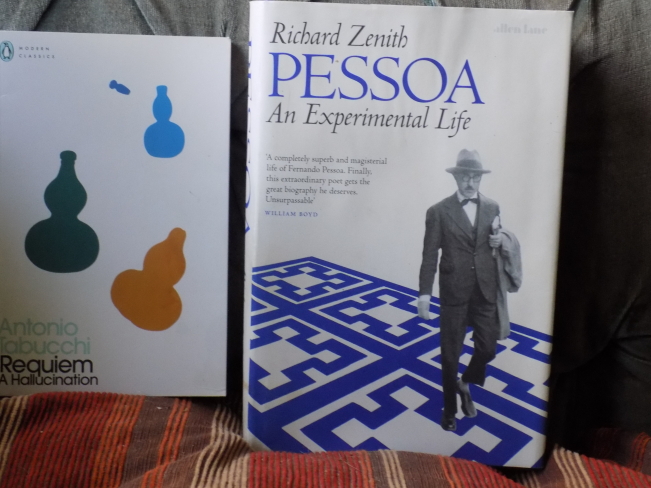
Two books. One is 1100 pages, the other 85. What binds them is the spirit of Fernando Pessoa, who died in his forties in 1935 after publishing little but writing a great deal. Five decades on, he, the very spirit of Lisbon, became better known as works emerged from the fabled trunk in which he stored them.
Most widely known is The Book of Disquiet. He wrote this meditation upon life's wiles under of one many heteronyms. That was his term, rather than pseudonym, for he reckoned that each had a distinct identity – one even being an engineer at a shipbuilding works in Newcastle.
In poetry and prose (including a series of detective stories yet to be translated), he revelled in the enigmatic, as he did in life, whose details in Zenith's telling become almost a world history seen from a Portuguese perspective. This is remarkable, for Pessoa's days comprised humble office work alleviated by conversation in various cafés. To judge by his clothes and his custom of being shaved daily by a barber, anybody would have assumed him to be well off; on the contrary, he lived from hand to moustached mouth.
Proust is not mentioned by Zenith but, while reading the biography, one thinks of the novelist's creation of another Marcel given to startling and convincing aphorisms about life. One might call Pessoa a public recluse. Zenith brings one as close to him in those cafés as it is now possible to do – and in a history which takes surprising turns, the biggest one comprises the last four sentences of the Epilogue.
It is just such an encounter which concludes Antonio Tabucchi's 1991 novella Requiem. He was born in Italy but, Pessoa-fashion, moved to Lisbon and wrote this novel in Portuguese. As others have done, he sets it during a hot summer's day, its narrator having both encounters and reminiscences whose dreamlike nature brings Pessoa back to puzzled life – especially when he is told that the restaurant in which they are sitting “is supposed to be post-modern, and if you'll forgive me, you may be partly to blame for all this. I mean for postmodernism.”
Do not let that term, which has become an ancient one, put you off exploring Pessoa - and learning Portuguese to get to those detective stories.
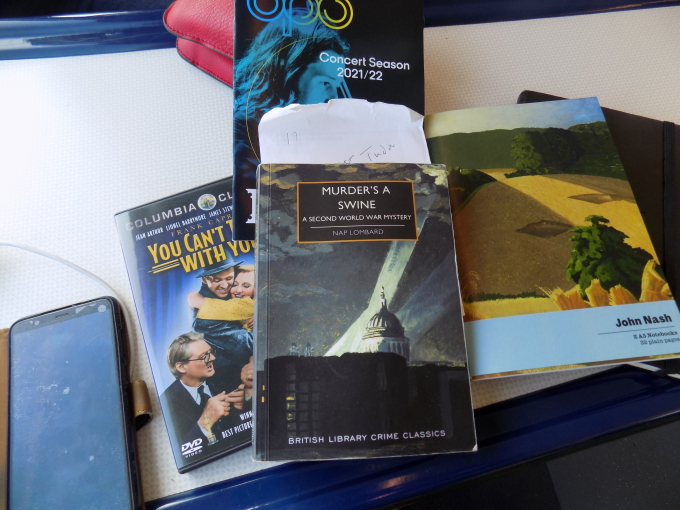
A BOOK ON THE SOFA XXI
Or, rather, on the 'bus. The top desk of the 12X between Brighton and Eastbourne sports a table (nab it at the first stop in both towns). As you can see, among the things I spread out in the sunshine, as the sea and Downs went by, was the British Library's recent reissue of Nap Lombard's Murder's a Swine in its Crime Classics series.
There are now about a hundred titles in this series of books from what is loosely called the Golden Age. If anything, these have become a word-of-mouth success. There is an audience for them. And here is one of the most unexpected. First published in 1943, and never seen again until now, this was the second and last collaboration between Pamela Hansford Johnson and her first husband Gordon Neil Stewart.
Events turn around the inhabitants of a mansion block on the north side of the Thames. Among them are Agnes and Andrew Kinghof who find themselves caught up in a murder, when a body is found amidst the sandbags during those nights of the Phoney War and, stretchers to the fore, practice runs at ARP work.
Naturally, somebody committed the murder but the novel is more of a thriller – trains and all – than a whodunnit. There is something of a Nora and Nick about this married couple, with references which suggest their bed was indeed pleasurable (Pamela Hansford Johnson's own first novel was – in 1935 – This Bed, Thy Centre, a title from Donne suggested by Dylan Thomas with whom she'd had a fling). And here, even more pleasure is provided by the banter and language as events unfurl, all of them accompanied by a pig's head and other porcine references.
How brilliantly the novel depicts those days and nights of rationing and blackouts when, for a consideration, champagne could be obtained if one knew where to ask. It is also a repository of contemporary language and dress.
“Hilary divested herself of her tweed jacket, revealing a a large, firm bust closely covered in canary wool. 'I say, Bubbles, turn round! I want to to look at that chevelure. Jumping snakes, there's plenty of lure about it.”
There are also references to “tootsy” clothes, for which there is not an exact parallel in the three volumes of Jonathon Green's three-volume Dictionary of Slang. Also new on me is “a tall, upstanding girl with fouff teeth”.
Whatever they might be, her height could be a problem. Two dozen pages later, there is: “the cottages were Tudor, delightful to the tourist, unpleasant for the inhabitant; but the most enthusiastic admirers of rural England do not, as a rule, have to live in it. If I were dictator, Agnes thought as was cautiously admitted into the beetle-browed shop that smelled so nostaligically of sugar mice and real mice, of flour liquorice and cheese, I should acquire all those lovely old houses as national monuments, and put the late inhabitants into decent modern houses with good baths and good drainage.”
As this novel shows, baths and drainage could remain a problem, however well-managed a modern mansion block might be. Especially with a killer on the loose. Jumping snakes, this novel is a delight – and one one must hope that its predecessor Tidy Death will re-appear soon.
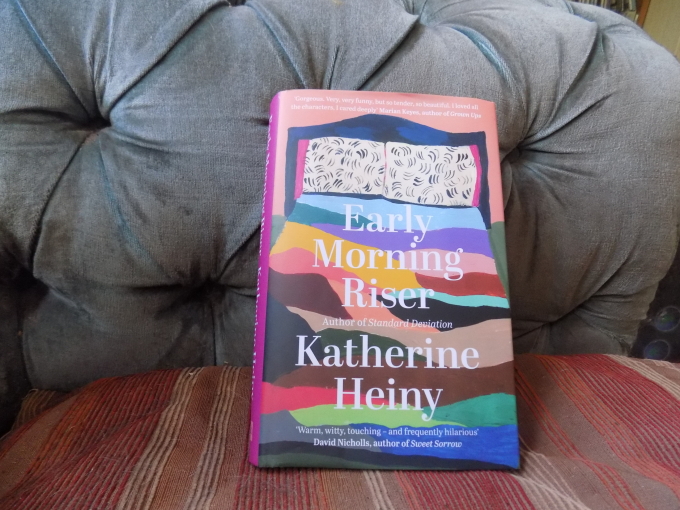
A BOOK ON THE SOFA XX
How many scenes can a novel contain? The thought comes to mind when reading Katherine Heiny's second one, the recently-published Early Morning Riser. One scene follows another at quite a pace in a chronicle of this century's two decades in an American small town where even those not sleeping with everybody else are soon aware of those who manage to find such time in their schedules.
Four pages in, one evening, a visiting tradesman, woodworker Duncan is slow at fulfilling orders – apart from one: he declares, “'I'm the luckiest man in Boyne City,' as he pulled Jane's pajama pants off while she lay back on the sofa.”
These two decades' narrative could be the stuff of an epic or, at least, Peyton Place and Cobweb. Both of those are very good novels but Early Morning Riser is something else. As Polly Samson has said, “it’s funny and warm and just what the doctor ordered”. Any doctor, though, should caution patients that it is likely to cause cracked ribs.
Here is a novel which has one yelling in delight on every page (as Kingsley Amis said of Elizabeth Taylor's Mrs. Palfrey at the Claremont - “and I mean yell!” he added). How does Katherine Heiny manage this? She has also written a glorious volume of short stories; she is adept at an inclusive scene. She does not leave that pajama-dropping moment at Duncan's remark about Boyne City.
“'But Boyne City is only about two hundred people!' Jane protested.
Duncan looked thoughtful. 'Actually, more like three thousand.'
'Still, you're supposed to say in the universe,' she said.
'How about North Michigan?' Duncan ran his hands up the insides of her thighs. 'Will that do? I'm the luckiest man in North Michigan.'
That was on a Friday, and neither Jane nor Duncan left the house until Monday morning, when Jane had to go to school.”
Nothing more need be added to that scene, whose last phrase draws us into Jane's job as an infant-school teacher. She is saddled with the most unruly mob since the evacuees in Waugh's Put Out More Flags or the children in Alison Lurie's The War Between the Tates.
One could jump the gun and open this novel anywhere to find such descriptions. One should resist. Oh, well, the temptation is there.
“Like her wedding dress, the barn seemed to have undergone some changes since Jane had last seen it, and not for the better. Or maybe Jane had seen it before only at night. Then it had been starlit and pastoral, the open barn doorway glowing like a golden rectangle. Here, now, soaked in the bright afternoon sunlight, the barn had a dilapidated look, the red paint faded clean away in places to reveal weathered gray planks. The double doors were propped open on sagging hinges. The ground was baked hardpan with only forlorn tufts of grass scattered here and there like spikey green hedgehogs.”
And that last phrase has the outlandishly unexpected but convincing turn of a Wodehouse metaphor.
Shelley once wrote of his friend Thomas Love Peacock's novels “...his fine wit/ Makes such a wound, the knife is lost in it”. Here, though, as Polly Samson suggests, Katherine Heiny does display compassion - but not at the expense of some wonderful uses of a knife which as soon as it sinks in re-surfaces to barbed and glistening effect (and, it's worth adding, cookery plays a part throughout this novel).
What is it that keeps this novel in the mind? E. M. Forster, in Aspects of the Novel , remarks, “in daily life we never understand each other, neither complete clairvoyance nor complete confessional exists. We know each other approximately, by external signs, and these serve well enough as a basis for society and even for intimacy. But people in a novel can be understood completely by the reader, if the novelist wishes; their inner as well as their outer life can be exposed. And this is why they often seem more definite than characters in history, or even our own friends; we have been told all about them that can be told; even if they are imperfect or unreal they do not contain any secrets, whereas our friends do and must, mutual secrecy being one of the conditions of life upon this globe”.
That last phrase by Forster could be the very stuff of a novel. Meanwhile Katherine Heiny has brought to her three-hundred pages an array of people whom one has come to know: one even cares for the rogues (infant and adult).
The only shame is that, for the English edition, rough paper has been used, redolent of that Eighties sort which bookdealers now say that it has “the usual yellowing”. Katherine Heiny's acid wit does not mean that the paper upon which it is etched should blister.
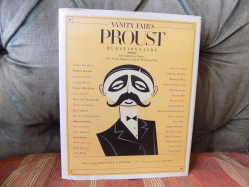
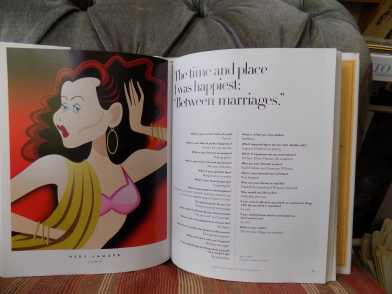
A BOOK ON THE SOFA XIX
Knowing of my enjoyment of Proust, a bookseller asked if I would be interested in this volume. The Proust connection is tangential but no less interesting for that. As Graydon Carter, editor of Vanity Fair, explains in an introduction. There was the suggestion, when he began to edit the magazine in the 1990s, that he revive (as others had done) a questionnaire which had circulated in Parisian salons a century earlier. The young Proust was one of those to do so – and it has become attached to his name (or vice versa).
An array of people answered Carter's questionnaire over the coming years, a hundred of them gathered here alphabetically to provide the sort of browsing that, each time, one keeps on turning the pages longer than expected.
Books surface throughout, as in David Bowie's reply to “What is your idea of perfect happiness?” “Reading” (in that year of 1998 his answer to “which living person do you most admire?” is “Elvis”. Meanwhile, Martin Scorcese's greatest regret is “not reading more when I was younger”. One often wonders if Trump has ready any books. His 2004 answer to “Who are your favorite writers?” is evasive: “There are so many great ones, I can't mention them all. But one of the best is one of the biggest sellers – myself.”
As well as answers as diverse of those who fill in the form, there are wonderful illustrations by Robert Risko – such as this one of Hedy Lamarr, famed for a night-time swim in a Thirties movie and for creating cellphone technology. As well as revealing in 1999 that her favourite writers are Kahil Gibran and Tennessee Williams, she replies to “How would you like to die?” with this: “Preferably after sex.” As a note below the piece records, she died the following year but, so far as I recalls, the circumstances are not known).
Put this book on a coffee table but have a cocktail while reading it.
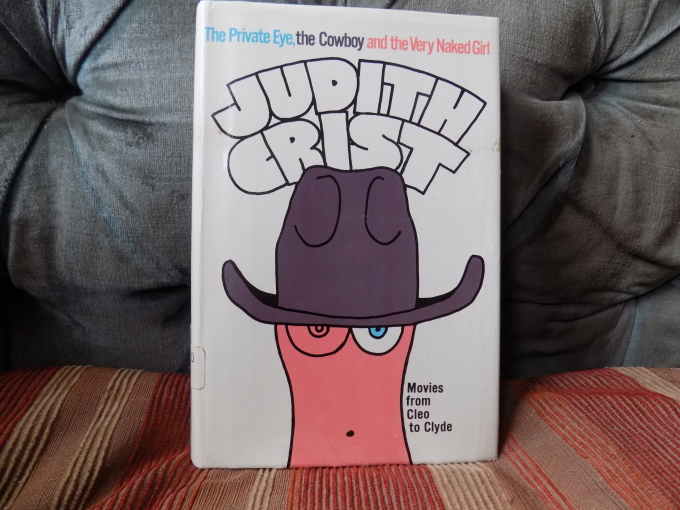
A BOOK ON THE SOFA XVIII
I am grateful to Lansing Community College Library, somewhere in America, but send its readers my sympathy. Meanwhile, I reflect upon how many film critics, their work gathered into one or more volumes, any of us turns as readily as one does Bernard Shaw's voluminous chronicles of the concert hall? Graham Greene, of course, and Otis Ferguson (dead in the war), not to forget Manny Farber, Eric Rohmer and Francois Truffaut. I find myself looking less at C. A. Lejeune and Dilys Powell, both of whom were accorded a volume in a series published by Carcanet some thirty years ago – which was a while after they commanded a huge audience in the Sunday papers. And, dare one say it, the many volumes by Pauline Kael do not often spring from the shelf; in her time, when she was granted inordinate space in The New Yorker, she soon turned prolix while catching some of the mood of Hollywood in the Seventies before Star Wars and its ilk won out, consigning to oblivion the spirit which enabled such maverick enterprises as The Last Detail.
And yet, especially by way of Robert Polito's Library of America anthology of film reviewers, there is always the chance of finding others. What a delight to discover Judith Crist (a surname which seems to lack a consonant). As you can see, the very title of this 300-page volume – The Private Eye, the Cowboy and the Very Naked Girl – and its cover are an emblem, as they say, of the Sixties.
Who was she? Older than many now thought redolent of the Sixties, she left Hunter College and Columbia to join the New York Herald Tribune in 1945 and learned to write about anything (something that both Kingsley Amis and Anthony Burgess said that a writer should be able to do, not that one would trust either of them with a surgical manual). When it came to collecting the film reviews which she wrote between 1963 and 1968, she added an introduction which looked back at her growing up and, in particular, at those long-gone picture palaces where the gilded ceilings were as absorbing as the screen. “Until we began growing up with the World War II, what we learned of our historical past and present, of our sociology and standards, of world situations and of human relations (including our fleshy ones: our first kisses were in the balcony, that haven of the sophisticates), came from that screen that was still predominantly silver.”
Where to turn in encapsulating her view of the cinematic world amidst world situations?
Something in the brain (where else?) made me think of President Kennedy's assassination, on November 22nd 1963 (the same day as C.S. Lewis and Aldous Huxley died). How did Judith Crist's latest review appear in the shadow of that (granted her deadline was earlier)?
“The question before us is, just how mad can you get on the subject of American comedy, let alone the world. Well, now that Stanley Kramer's gone quadruply mad, we have the essence of of the Hollywood comedy that Hollywood has been ignoring for much too long.”
This at a time when, one had gathered, the nation's mood was so dampened that it did not buy Phil Spector's Christmas album and, as the long winter reached February, welcomed the Beatles' cheerful spirits. Judith Crist was reviewing Kramer's It's a Mad, Mad, Mad, Mad World – a title she would never have associated with “a man hitherto dedicated to the making of socially significant and serious movies”.
Kramer's title has always put me off watching the film, which seems to anticipate those adjective-laden film titles later in the decade they led William Boyd to create one of his own in the recent, Brighton-set novel Trio.
I was, perhaps, wrong.
Judith Crist links it with those silents whose “hallmark is the chase, its concomitants being confusion, crash-bang devastation and full exploitation of the individual talents of the comedian. Stupidity, venality, pomposity, dishonesty, hypocrisy – the human vices and frailties are taken to pieces along with the furniture and the masonry”.
This is wonderfully concise, off-the-cuff observation. Another aspect of Kramer's film that may well put off later viewers is that it appears to be one of those Sixties outings – Casino Royale, What's New Pussycat? - which bundles an ill-matched array of international stars, a galaxy which swiftly implodes. On the contrary, everybody is in it (er, Spencer Tracy and Sid Caesar with a side salad of Ethel Merman and Terry-Thomas), but “we haven't seen such a salute to the gift of lunacy for decades”.
How might the film seem, six decades after such prose which I think many notches above Pauline Kael? I shall find out, forthwith. Every page of Judith Crist's book contains as many plums as, well, Plum's (a name by which P.G. Wodehouse was rightly known).
As for the readers at the Library in Lansing. Copies of the book, published in October 1968, and reprinted the next month, are now hard to find, and I was happy to get this one, albeit with an emphatic DISCARDED stamped upon the top edge.
Make no mistake, Judith Crist is not discarded.
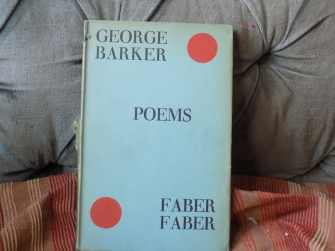
A BOOK ON THE SOFA XVII
I have a large volume of George Barker's Collected Poems but could not resist this first edition, in a wrapper, of his first, 1935 volume simply called Poems.
There is much to be said for reading poems in slim volumes – and how many of those first volumes lead to a hefty collected?
What's more, this copy's pages have not been cut, and I must be careful about doing so.
Meanwhile, pondering such matters temporal, I lighted upon this one:
“I too will end. I too
Supple of sheer muscle tend apart,
A perianth the head shed to decay
And spinal stalk too wither...”
There is more such traversal of fragile body: seek it out while pondering that image of one's head as a floral envelope.
What's more, in thinking about an envelope, the volume's near-pristine wrapper tells us about the contents:
“Those who look for new poets will remember a few poems, in the Criterion, the Listener, New Verse, and one or two other periodicals, which could not be classified as paraphrases or imitations of any of the living poets now generally admired. Some of these poems have been over the signature of George Barker. There are many people who have wanted to see more of George Barker's work, so that they might make up their minds about him. This volume gives them the opportunity of committing themselves to an opinion of a poet younger than those whom they have recently been discussing.”
Authors sometimes draft their dustflap copy. Given the Romantic timbre of George Barker's poems, it is hard to think that he had any hand in that Classical paragraph (accurate though it is). This was surely the work of his publisher T. S. Eliot.
Be that as it may, the £3.50 I spent on it today was surely an even better bargain than the six shillings it cost more than eight decades ago.
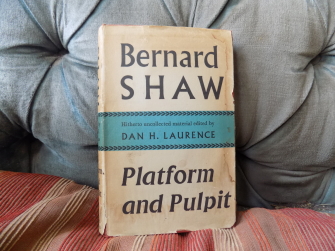
A BOOK ON THE SOFA XVI
Seven decades after Shaw's death, one might not hasten across country to see a staging of his plays. Which is perhaps unfair, for, when one does watch them, it is invariably with great enjoyment. As with Wilde, it is fair to say that his plays are rooted in the the journalism to which he gave much time and energy. Now compiled in three substantial volumes, his music criticism is well-nigh matchless, or perhaps one should say matchful as it remains incendiary stuff – and highly informed.
New to me, though, is this volume, published eleven years after his death. As you can see, this copy appears to have been well read – and no wonder. Dan Laurence, who gave more of his life to Shaw than the playwright did himself, explains that he collected these pieces which Shaw delivered on the hoof to audiences in halls which helped to create a public for his work. Time was, when people readily turned out to hear lectures and addresses, and so perhaps it is in our own era: podcasts and TED talks.
To collect these talks required some work of Laurence, for Shaw – rightly so – thought that it was cheating to stand up and read out something which he could have simply printed. That would have denied himself and a paying public the dramatic force which an audience can inspire (something which comes close to the Barthesian notion of reader as author).
These three-hundred pages bring one close to such an evening out.
Among such jaunts is a 1911 gathering. On June 13th in London he addressed the Annual Meeting of the Coal Smoke Abatement Society, where he proposed the notion that “this meeting, recognising the harmful effect of coal smoke on life and property, pledges itself to support the efforts of the Coal Smoke Abatement Society in diminishing the evil.”
This was, of course, prescient, for it was not until the Fifties, after lethal “peasoupers” killed many, that measures were taken – and still need to be taken 110 years after his address as we contend with a Climate Emergency.
Being Shaw, however, he promptly took another tack rather than weary an audience with statistics.
“I would like to make a few remarks on the nature of genius. You might say that genius has nothing to do with smoke abatement and that is not what you have come to listen to. But I know little about smoke, which is a common thing, and everything about genius. I am in that line myself.”
A Wildean flourish which brought laughter. His point is that genius, by being focussed on one thing to the point of apparent eccentricity, can see matters to which others are blind. “To the ordinary inefficient mind there is one thing which can be seen over and over again without any importance being attached to it, and that is a smoking chimney.”
Such chimneys had been around for decades, since the advent of the Industrial Revolution. Similarly, a century on from Shaw's address, it has taken decades for people and politicians to wise up to the continual warnings of lone scientists about the coming peril – and, even now, former President Trump unites with those who slather in the readers' comments columns to deny that there is a problem.
Shaw proves to be all the more our contemporary, in the same address, by talking of the linked subject of washing: if one did not need to rid one's body and clothes of smoke-driven pollutants, one would not need to clean oneself so often. And he anticipated Win Hof: “it is true I have got into the habit of taking a cold bath; but that is not washing. I do it as a stimulant, and I often think I had better have taken to whisky.”
Again he aroused laughter, which brought people on his side, recognising that “a clean atmosphere would probably prolong our lives and enable us to save money”.
What an advocate he would have made for solar panels (not to mention the current penchant for summerhouses: there is film of him in the revolving one which he designed to catch – or perhaps avoid - the sun throughout the day).
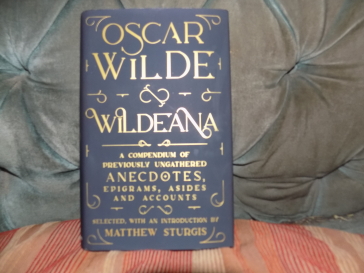
A BOOK UPON THE SOFA XV
Browse. The word was originally used to describe the way in which animals graze upon vegetation. And, in some moods, this is the very way that one can productively read a book, sampling here and there, getting a sense of what might draw one further in, and then going from the beginning to the end for nourishment.
This could indeed be the way to approach – as you can see – a neat collection of little-known anecdotes about Oscar Wilde. Published last year, but with no reviews that I saw, it is compiled by Matthew Sturgis who had recently published the best biography of Wilde, one more in the spirit of the man than the stolid one by Richard Ellmann over three decades ago.
As Matthew Sturgis mentions in a brief preface, he set about this pendant to his biography by, well, browsing. For a month he pulled books off the shelf in the London Library, flipped their pages and – as we can see – pulled out nuggets from long-vanished memoirs by those fortunate enough to have encountered Wilde here (and in America, where his arrival went unmatched until that of the Beatles in 1964).
One would not wish to spoil readers' enjoyment by quoting too much. Here is a taste. G.P. Jacomb-Hood's With Brush and Pencil (1925) hereby sees some light of day again.
“About that time [publication of The Happy Prince] he came to stay a few days, between two country-house visits in Dorset, with me and three other friends in a cottage let to us, on Brownsea Island, by our friend Frederick Cavendish Bentinck. As we only had an old woman who came in to cook and 'do' for us there, our ménage was not luxurious, but Wilde seemed thoroughly to enjoy it. His only want was a cup of tea before getting up in the morning, for the getting of which I had to rise, light the kitchen fire, and boil some water. 'My dear Jacomb! I positively cannot open my eyes without a cup of tea.' He joined like a schoolboy in the early-morning plunge in the harbour from the castle steps, and we spent most of our days sailing in small boats in Poole Harbour or on the sea.”
This is new to me. I feel sure that I would have remembered the combination of tea and Poole had I read it before. Matthew Sturgis has produced a beguiling entertainment, and includes some extracts from early drafts of the plays (elsewhere on this site – under Books – I have written at length on the evolution of The Importance of Being Earnest). One might also urge readers to seek out Wilde's journalism: even when he is reviewing a long-forgotten book, it is as though he is in the room with us and talking of it over tea or something stronger.
One's only regret is that this book is not printed on better paper; it will soon be yellow, unlike so many of those, over a century old, which inspired Matthew Sturgis's mining expedition in the London Library.
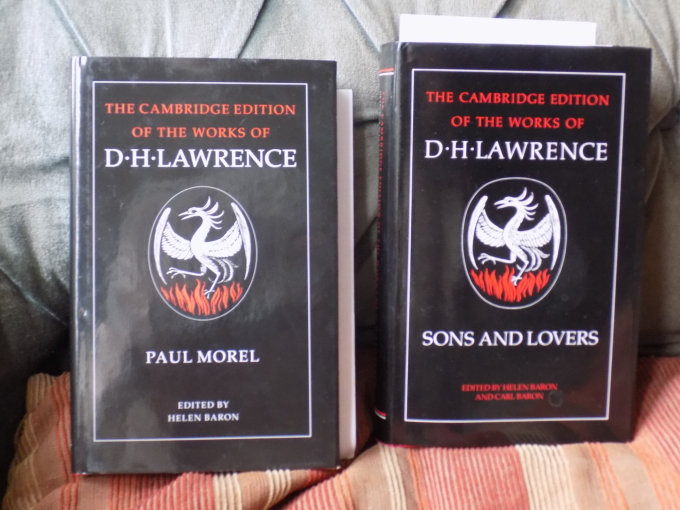
A BOOK ON THE SOFA XIV
There have been many books about writing a novel. The upshot of this is that any writer finds a way. The crucial lesson is not to be daunted by mistakes. The first blows of the chisel into the marble are far from the finished item. D. H. Lawrence evolved a method at the beginning of his career of writing, from scratch, several versions of a novel. He even rewrote a novel, The Boy in the Bush by somebody else – Mollie Skinner.
During two years he wrote four versions of Sons and Lovers. Come 1913, that fourth version was pruned, and more, by the well-known editor Edward Garnett. The full text has been published in the Cambridge edition, and one inclines to favour Lawrence's final thoughts rather than his contemporary thanks to Garnett for that wielding of a pencil.
Perhaps all the more interesting is publication of the second draft, as Paul Morel. It is far shorter, sometimes sketchier in its conception of the troubled household, and events take a melodramatic turn. Equally, it contains some comedy downplayed in the final version. In particular, there is a glorious appearance by a rescued rabbit, a creature who brings out some welcome spirit in Paul's father.
“Adolphus, the friskiest atom, would give a wild start at the jam, turn, dart six inches, then reconsider himself. He climbed with his fore-feet on the rim of the sugar basin, and helped himself to a lump; this before he had been in the house a week.”
This is the prose of a man born to write.
Lost is the opening part of the second draft, and this edition prints in its place the opening of the third draft. Here, Lawrence evokes the end of day.
“The sun was going down. It is a countryside famous for its sunsets. Every open evening, the hills of Derbyshire blaze up like a beacon.This night Mrs Morel watched the sun sink from the glistening sky, leaving a soft, flower-blue overhead, while the western space went red, as if all the fire of the day had swum down, leaving the bell cast flawless blue. The mountain-ash berries across the field were like coals among the dark leaves, that were overcast with crimson.”
Any of us would relish writing that. Lawrence did not leave it there.
Here is the final version.
“The sun was going down. Every open evening, the hills of of Derbyshire were blazed over with red sunset. Mrs Morel watched the sun sink from the glistening sky, leaving a soft flower-blue overhead, while the western space went red, as if the all the fire had swum down there, leaving the bell cast flawless blue. The mountain-ash berries across the field stood fierily out from the dark leaves, for a moment.”
It is possible to prefer the third draft, with that touch of crimson, and the assertion about Derbyshire's fame.
We live in times when many people post online photographs of sunsets less redolent than Lawrence's prose but we are also in what might be called The Age of the Archive: one can listen to a dozen versions of Bob Dylan's masterly, if unfinished “She's Your Lover Now” and read the version of The Importance of Being Earnest as first staged – without the additional, brilliant lines which Wilde created after Reading Gaol. I am partial to the version of Pink Floyd's “Wish You Were Here” with Stephane Grappelli (even more surprising, in that Abbey Road encounter, would have been Menuhin taking a solo on it).
Life is short, art survives it; perhaps one should use this time to read widely, but to go in these circles on the Derbyshire hills can prove rewarding, an inspiration to anybody who, Klee-like, takes a pen out for a walk across the page.
A bosh shot is the prelude to success.
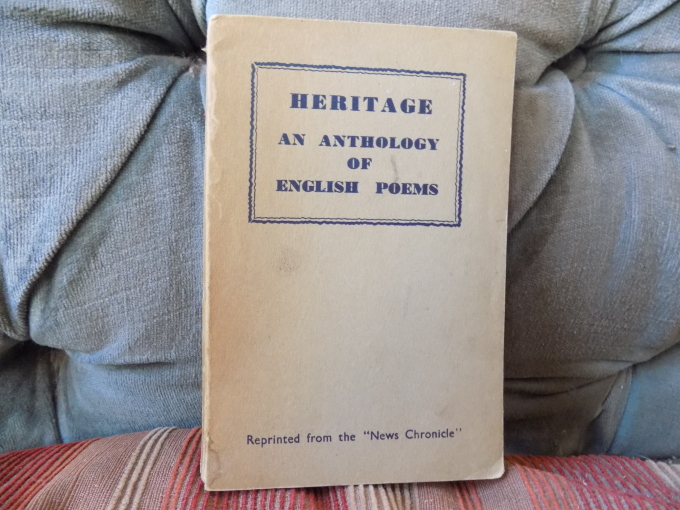
A BOOK ON THE SOFA XIII
The other day a Hove resident gave me this little book which had been published by the News Chronicle at the end of 1941. Well produced by that newspaper, with sewn binding, this paperback included some of the poems which it had reprinted each day during the year. A preface notes, “war counts among its horrors the power to make us forget beauty. When we fight, we fight as much for the preservation of that beauty as we do for our freedom and our lives”.
And now, eighty years on, there leapt from these pages one evening in Hove a poem called “Light” by F. W. Bourdillon.
What? Who?
It is eight lines in length.
“The night has a thousand eyes,
And the day but one;
Yet the light of the bright world dies
With the dying sun.
The mind has a thousand eyes,
And the heart but one;
Yet the light of a whole life dies
When love is done.”
Bourdillon, who was born in 1852, died in 1921 – four decades before his opening phrase would be heard upon Bobby Vee's lips. What's more, it had already been the title of a Forties movie, with accompanying music. Splendid as the Vee song is, with those sweeping strings, it is essentially about jealousy awaiting a tip-off from those thousand eyes about a lover seen in the company of a rival.
The poem takes another tack, perhaps. Bourdillon, who was brought up in Cheshire and of a religious disposition, spent much of his life in Sussex. The poem has a metaphysical nature. Night's stars, many as they are, cannot match the life-sustaining power of the single orb that is the Sun.
Which is true, so far as it goes. And yet, Bourdillon's second quatrain brings that physical, astronomical assertion within somebody's state of being. That is, reason – the mind – might say that when a lover has gone, there might be others and yet the heart – another single orb – can deem otherwise.
All of which is to say that, in effect, Bourdillon's poem is not so far from Bobby Vee. Time to seek out more of Bourdillon, and if the rest does not match that line, well, an evocative phrase is more than most of us will leave behind us as the Sun burns out and more stars emerge in the night sky.
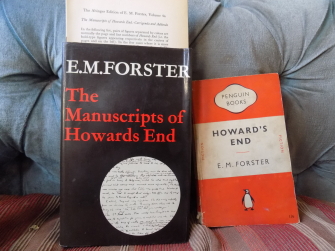
A BOOK ON THE SOFA XII
How on earth did this front cover for the 1950 Penguin edition get past so many eyes? One recalls that, similarly, Anthony Burgess threw aside any book which referred to Finnegan's Wake.
As B.J. Kirkpatrick's Bibliography of Forster notes, there were 40,000 copies printed of this Penguin (she does not remark that it is the Forsterian equivalent of the Devil's Bible - “Thou shalt commit adultery”). Earlier, wartime Penguins – 110,00 copies – had not sported this howler.
We can only assume that the cover was not sent to Forster himself before publication (he was vexed later in life when sent a re-bound copy of the novel for signature and its spine contained this appalling apostrophe: perhaps he thought it a greengrocer's work).
Meanwhile, come 1973, three years after Forster's death, there appeared The Manuscripts of Howards End. Only a thousand copies were printed (and numbered). As you can see, the title is accurately rendered, but the transcription by its editor Oliver Stallybrass prompted a scholarly article by John H. Stape with many corrections which was then issued with the book by publisher Edward Arnold (it protrudes in this photograph).
All of this might seem geekish, but there is a human factor. That editor, Oliver Stallybrass, had hoped to be elected a Fellow of King's College, Cambridge to continue his work on the Edition of Forster. Word is that the Howards End mistranscriptions put the kibosh on that. He had been working on the Edition amidst freelance work of a diverse kind, including translations. So disappointed was he by this rejection that he died in 1978, upon a railway track (an end which, of course, recalls The Longest Journey, which was Forster's favourite of his novels).
Almost five decades have gone by since Stallybrass's death. Meanwhile, he had worked upon A Room With a View, which was accompanied by the now-scarce The Lucy Novels (1977) which now commands £200 and more. These early versions of the novel are presented in quite a readable form. Unlike those for Howards End and A Passage to India, whose system – amidst page lines - of arrows and brackets upon brackets for Forster's later thoughts turn any reader into a contortionist.
In this Age of the Archive, when innumerable takes by Bob Dylan bring a paying audience, could we see a first, uninterrupted, arrowless draft of these Forster novels? As there has been of many a Lawrence novel.
For one thing, it would make many a novelist nowadays – and beyond – feel undaunted at the need to start over as a part of the creative process.
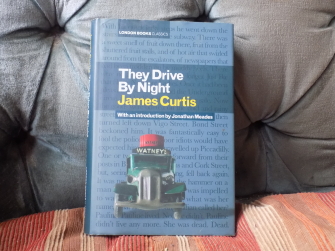
A BOOK ON THE SOFA XI
Time was when a Cambridge critic called F. R. Leavis held sway and laid down the law on novels that were granted room in what he called The Great Tradition. He is now rarely mentioned. People in universities and at large have wised up to the fact one can read widely - just as Graham Greene was an enthusiast for Henry James and the rather more hard-boiled W.R. Burnett.
And so it is that James Curtis, who died in Kilburn bedsit obscurity in 1977, is now recognised as an astute chronicler of Thirties lowlife. They Drive by Night (1938) was swiftly filmed in England, and, a few years later in Hollywood (with Bogart). And what a corker it is. As I write that noun, I break off to consult the three hefty volumes of Jonathon Green's wonderful dictionary of slang. It turns out that the first recorded instance of corker is by one T. Brierley in 1870. Corker could also mean an alcohol, such as rum, which keeps out the cold (an 1808 usage which came from Jamaica and could be revived now). This digression into slang is apt, for They Drive by Night is full of it, buttressing a tale which can be simply summarised.
Albert Mathews, known as Shorty, is about to be released from gaol again. Soon after taking a breath of outside air that morning, he is back in Soho, where he finds that his girlfriend, who is on the game, has been strangled with a silk stocking. He panics rather than go to the police and, of course, is the prime suspect while the killer lurks elsewhere. He takes to the road, hitching lifts from the trucks which ply the Great North Road.
Encounters along the way are swift and varied, many springing from transport caffs as fog descends and rain beats upon the windscreens. This is the familiar stuff of pursuit and temporary sanctuary, with quite a few cases of girls hoping for ten shillings for pleasuring those who have taken them aboard the rattling vehicles. What distinguishes all this, bold for its time, is Curtis's language. It is realistic and yet fantastic, his skill such that one need not break off to look up what a slang term might mean. Here we have the higher sordid. Thereby hangs another tale. At one point, for example, a truck driver suggests they stop for some “ackermaracker”, which is evidently tea (one can picture the thick brew poured from the spout by a sullen counterhand). Come the moment, after the last page closes, one looks this up in Green's volumes and finds that it is there, the only citation being this one - with the speculation that it might be a variation upon “cha”. As Jonathan Meades points out in his introduction, Green's dictionary contains three hundred citations from this novel. Whether on many lips at the time or not, here is something distinctive: one is putting the ear with a glass against the neighbouring wall of history.
And all the while, the story, with one subterfuge after another, keeps going. Fittingly, the reader - as much as Shorty - cannot stop after climbing aboard. Put your feet up with a glass of corker as the winds blow outside, and let Curtis put his foot on the gas, and you'll have a gas.
